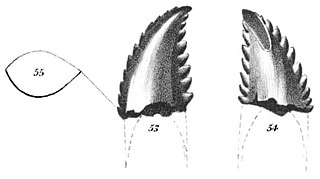
Troodon is a former wastebasket taxon and a potentially dubious genus of relatively small, bird-like dinosaurs known definitively from the Campanian age of the Cretaceous period. It includes at least one species, Troodon formosus, known from Montana. Discovered in October 1855, T. formosus was among the first dinosaurs found in North America, although it was thought to be a lizard until 1877. Several well-known troodontid specimens from the Dinosaur Park Formation in Alberta were once believed to be members of this genus. However, recent analyses in 2017 have found the genus to be undiagnostic and referred some of these specimens to the genus Stenonychosaurus and others to the genus Latenivenatrix.

Camptosaurus is a genus of plant-eating, beaked ornithischian dinosaurs of the Late Jurassic period of western North America. The name means 'flexible lizard'.
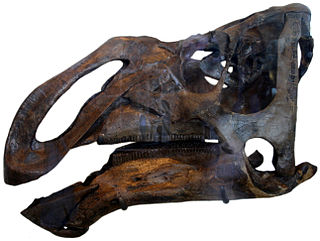
Kritosaurus is an incompletely known genus of hadrosaurid (duck-billed) dinosaur. It lived about 74.5-66 million years ago, in the Late Cretaceous of North America. The name means "separated lizard", but is often mistranslated as "noble lizard" in reference to the presumed "Roman nose".
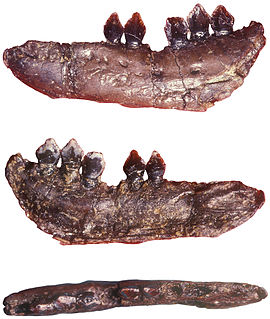
Echinodon is a genus of heterodontosaurid dinosaur that lived during the earliest Cretaceous of southern England in the Berriasian epoch. The first specimens were jaw bones named Echinodon becklesii by Sir Richard Owen in 1861, and since their original description only additional teeth have been discovered. The specific name honours collector Samuel Beckles who discovered the material of Echinodon and many other taxa from across England, while the genus name translates as "prickly tooth" in reference to the dental anatomy of the taxon.
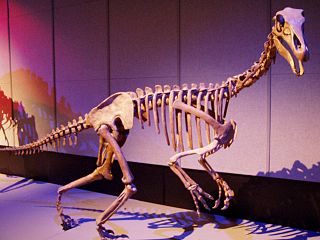
Alxasaurus is a genus of therizinosauroid theropod dinosaurs from the Early Cretaceous Bayin-Gobi Formation of Inner Mongolia. They are some of the earliest known members of the Therizinosauroidea, but they already possessed the body shape—including the long neck, short tail, and relatively large claws—of later therizinosauroids. Like other members of this group, it was a bipedal herbivore with a large gut to process plant material. Several specimens are known and they vary in size.
Polyodontosaurus is a potentially dubious genus of troodontid dinosaur named in 1932 by Gilmore for a left dentary from the Dinosaur Park Formation. It had been considered a synonym of Stenonychosaurus or Troodon for a significant time, before being declared a nomen dubium.

Nuthetes is the name given to a dubious, possibly dromaeosaurid, genus of theropod dinosaur, known only from fossil teeth and jaw fragments found in rocks of the middle Berriasian age in the Cherty Freshwater Member of the Lulworth Formation in England. As a dromaeosaurid, Nuthetes would have been a small predator.

Phuwiangosaurus is a genus of titanosauriform dinosaur from the Early Cretaceous (Valanginian-Hauterivian) Sao Khua Formation of Thailand. The type species, P. sirindhornae, was described by Martin, Buffetaut, and Suteethorn in a 1993 press release and was formally named in 1994. The species was named to honor Princess Maha Chakri Sirindhorn of Thailand, who was interested in the geology and palaeontology of Thailand, while the genus was named after the Phu Wiang area, where the fossil was discovered.
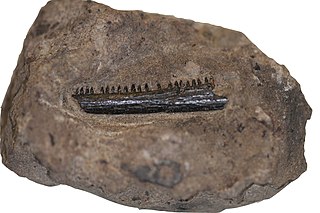
Cteniogenys is a genus of choristodere, a morphologically diverse group of aquatic reptiles. It is part of the monotypic family Cteniogenidae. The type, and only, species, C. antiquus, was named in 1928 by Charles W. Gilmore.
Paramacellodus is an extinct genus of scincomorph lizards from the Early Cretaceous of England the Late Jurassic of Portugal and the western United States. The type species, Paramacellodus oweni, was named in 1967 from the Purbeck Formation in Dorset, England. Additional material referable to a species of Paramacellodus, possibly P. oweni, has been described from the Morrison Formation, specifically in Como Bluff, Wyoming, and Dinosaur National Monument, Utah. Paramacellodus belongs to an extinct family of scincomorphs called Paramacellodidae, which spanned most of Laurasia during the Late Jurassic and Early Cretaceous and represented one of the earliest evolutionary radiations of lizards.

Paleontology or palaeontology is the study of prehistoric life forms on Earth through the examination of plant and animal fossils. This includes the study of body fossils, tracks (ichnites), burrows, cast-off parts, fossilised feces (coprolites), palynomorphs and chemical residues. Because humans have encountered fossils for millennia, paleontology has a long history both before and after becoming formalized as a science. This article records significant discoveries and events related to paleontology that occurred or were published in the year 2010.
Brasiliguana is a genus of iguanian lizard which lived during the late Cretaceous period in what is now Brazil. It is known from the holotype MN 7230-V, an isolated left maxilla with partially preserved teeth, which was found in the Upper Cretaceous Adamantina Formation, part of the Bauru Group of São Paulo State, southeast Brazil. Brasiliguana was named by William R. Nava and Agustín G. Martinelli in 2011 and the type species is Brasiliguana prudentis. The generic name refers to its provenance from the Late Cretaceous of Brazil and iguana, from the South American and Caribbean aboriginal language meaning "lizard". The specific name, prudentis, refers to Presidente Prudente Municipality, where the holotype was found.
Paleontology or palaeontology is the study of prehistoric life forms on Earth through the examination of plant and animal fossils. This includes the study of body fossils, tracks (ichnites), burrows, cast-off parts, fossilised feces (coprolites), palynomorphs and chemical residues. Because humans have encountered fossils for millennia, paleontology has a long history both before and after becoming formalized as a science. This article records significant discoveries and events related to paleontology that occurred or were published in the year 2012.

The Lacertoidea is a group of lizards that includes the Lacertidae, Teiidae, Gymnophthalmidae, and the burrowing Amphisbaenia. Laterata …referring to the presence of tile-like scales that form the rings in Amphisbaenia, and are also present ventrally in Lacertiformata (Lacertidae) and Teiformata (Teiioidea)”.
Paramacellodidae is an extinct family of scincomorph lizards that first appeared in the Middle Jurassic around 170 million years ago (Ma) and became extinct in the Early Cretaceous about 100 Ma. It was one of the earliest groups of lizards to have undergone an evolutionary radiation, with members found across the supercontinent Laurasia. The phylogenetic relationships and constituent species of Paramacellodidae are uncertain. Many studies regard it to be closely related to Scincoidea, a large group that includes skinks and their closest extinct relatives, and possibly also to Cordyoidea, a group that includes spinytail lizards and relatives. Like modern skinks, paramacelloidids had rectangular bony plates called osteoderms covering most of their bodies, including their backs, undersides, and tails. They also had short and robust limbs.
Purbicella is a genus of extinct squamate from the Early Cretaceous of southern England. The type and only species is Purbicella ragei, which was described by Susan E. Evans and colleagues in 2012 for a mostly complete and articulated skull from the Berriasian Lulworth Formation of Dorset. The generic name described the region of Purbeck where the fossil was found, while the species name honours paleoherpetologist Jean-Claude Rage. Purbicella has the most complete skull of any British fossil lizard, British Geological Survey (BGS) specimen GSb581, which was originally collected prior to 1911, but then remained in BGS storage until it was rediscovered and described by Evans and colleagues. The skull is unique among coexisting taxa for having fused frontal bones, and Purbicella is likely closer to modern lacertoids than any of the other British forms.
Globauridae is a family of extinct scincomorph lizards that first appeared in the Late Jurassic of England and persisting until the Late Cretaceous of Mongolia. The group is distinguished by having a diploglossopalatinar palate anatomy, lacking osteoderms, having conical two- or three-cusped teeth, and a unique postorbital-parietal contact. The type genus Globaura was originally classified within the now-polyphyletic group Lacertoidea, before being reclassified within its own family within Ardeosauroidea. However, Meyasaurus has also been found to be closer to Barbatteiidae.
Parasaurillus is a genus of extinct lizard from the Early Cretaceous of southern England. The type and only species is Parasaurillus pseudobtusus, named in 2002 by Susan E. Evans and Belinda Searle for extensive jaw and tooth material that has previously been classified as either Saurillus obtusus or Pseudosaurillus from the Berriasian Lulworth Formation. The taxon was found in the Mammal Bed near the base of the formation alongside the other lizards Becklesius, Dorsetisaurus, Durotrigia, Paramacellodus, Pseudosaurillus, Parviraptor and Saurillus obtusus. It is likely closely related to Scincoidea, more so than other contemporary taxa.
Pseudosaurillus is a genus of extinct lizard from the Early Cretaceous of southern England. The type and only species is Pseudosaurillus becklesi, named in 1967 by R. Hoffstetter limited jaw and tooth material from the Berriasian Lulworth Formation. A large amount of material that was additionally referred to Saurillus by Hoffstetter was reassigned to Pseudosaurillus in 1983 by Estes, but this has since been reclassified within its own genus Parasaurillus by Susan E. Evans and Belinda Searle in 2002. The taxon was found in the Mammal Bed near the base of the formation alongside the other lizards Becklesius, Dorsetisaurus, Durotrigia, Paramacellodus, Parasaurillus, Parviraptor and Saurillus. Like Becklesius, Pseudosaurillus may be a member of the family Paramacellodidae.









